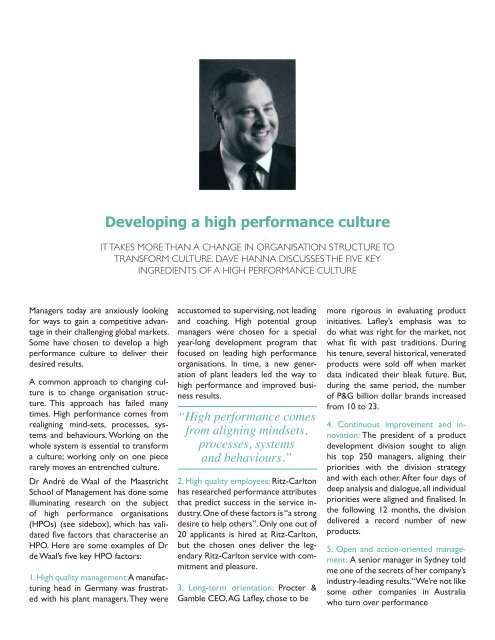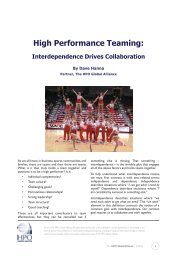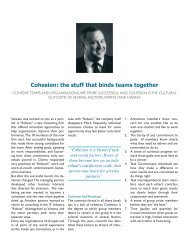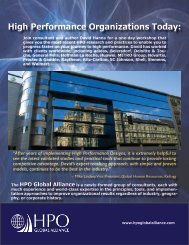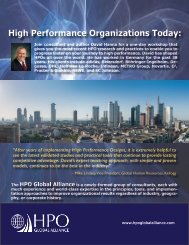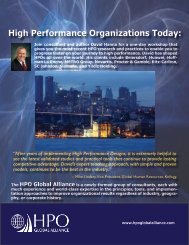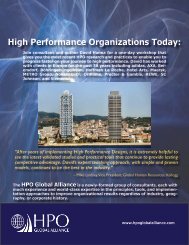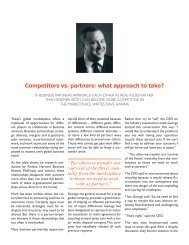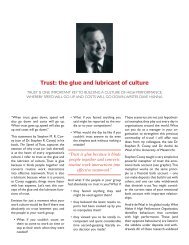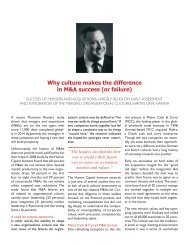3 Developing A High Performance Culture
Create successful ePaper yourself
Turn your PDF publications into a flip-book with our unique Google optimized e-Paper software.
<strong>Developing</strong> a high performance culture<br />
IT TAKES MORE THAN A CHANGE IN ORGANISATION STRUCTURE TO<br />
TRANSFORM CULTURE. DAVE HANNA DISCUSSES THE FIVE KEY<br />
INGREDIENTS OF A HIGH PERFORMANCE CULTURE<br />
Managers today are anxiously looking<br />
for ways to gain a competitive advantage<br />
in their challenging global markets.<br />
Some have chosen to develop a high<br />
performance culture to deliver their<br />
desired results.<br />
A common approach to changing culture<br />
is to change organisation structure.<br />
This approach has failed many<br />
times. <strong>High</strong> performance comes from<br />
realigning mind-sets, processes, systems<br />
and behaviours. Working on the<br />
whole system is essential to transform<br />
a culture; working only on one piece<br />
rarely moves an entrenched culture.<br />
Dr André de Waal of the Maastricht<br />
School of Management has done some<br />
illuminating research on the subject<br />
of high performance organisations<br />
(HPOs) (see sidebox), which has validated<br />
five factors that characterise an<br />
HPO. Here are some examples of Dr<br />
de Waal’s five key HPO factors:<br />
1. <strong>High</strong> quality management: A manufacturing<br />
head in Germany was frustrated<br />
with his plant managers. They were<br />
accustomed to supervising, not leading<br />
and coaching. <strong>High</strong> potential group<br />
managers were chosen for a special<br />
year-long development program that<br />
focused on leading high performance<br />
organisations. In time, a new generation<br />
of plant leaders led the way to<br />
high performance and improved business<br />
results.<br />
“<strong>High</strong> performance comes<br />
from aligning mindsets,<br />
processes, systems<br />
and behaviours.”<br />
2. <strong>High</strong> quality employees: Ritz-Carlton<br />
has researched performance attributes<br />
that predict success in the service industry.<br />
One of these factors is “a strong<br />
desire to help others”. Only one out of<br />
20 applicants is hired at Ritz-Carlton,<br />
but the chosen ones deliver the legendary<br />
Ritz-Carlton service with commitment<br />
and pleasure.<br />
3. Long-term orientation: Procter &<br />
Gamble CEO, AG Lafley, chose to be<br />
more rigorous in evaluating product<br />
initiatives. Lafley’s emphasis was to<br />
do what was right for the market, not<br />
what fit with past traditions. During<br />
his tenure, several historical, venerated<br />
products were sold off when market<br />
data indicated their bleak future. But,<br />
during the same period, the number<br />
of P&G billion dollar brands increased<br />
from 10 to 23.<br />
4. Continuous improvement and innovation:<br />
The president of a product<br />
development division sought to align<br />
his top 250 managers, aligning their<br />
priorities with the division strategy<br />
and with each other. After four days of<br />
deep analysis and dialogue, all individual<br />
priorities were aligned and finalised. In<br />
the following 12 months, the division<br />
delivered a record number of new<br />
products.<br />
5. Open and action-oriented management:<br />
A senior manager in Sydney told<br />
me one of the secrets of her company’s<br />
industry-leading results. “We’re not like<br />
some other companies in Australia<br />
who turn over performance
What makes a high performance<br />
organisation (HPO)?<br />
management to the human resources<br />
function. We own up to our responsibility<br />
to manage and guide our people<br />
to improve their performance.”<br />
You should not assume from these five<br />
examples that these companies did<br />
only the one thing described here to<br />
develop a high performance culture.<br />
Each company also realigned other elements<br />
of their whole system.<br />
“In the world of culture<br />
transformation, each<br />
organisation’s starting point<br />
may differ and each path to<br />
the goal may vary”<br />
In the world of culture transformation,<br />
each organisation’s starting point may<br />
differ and each path to the goal may<br />
vary, but at some point all five HPO<br />
factors must be in force for a real high<br />
performance culture to emerge.<br />
Dave Hanna is a principal at The RBL<br />
Group, a global professional services firm<br />
committed to creating value through leadership<br />
and talent, strategic HR, and aligned<br />
organisation and capability.<br />
(From “<strong>Developing</strong> a high performance culture,” Inside HR, Issue 3 2014)<br />
Dr André de Waal of the Maastricht<br />
School of Management has researched<br />
the answer to this question. His studies<br />
of 2500 organisations worldwide summarise<br />
the attitudes and behaviours<br />
that deliver truly high performance. 1<br />
HPO factors<br />
1. <strong>High</strong> quality management: decisive;<br />
action-oriented; strong relationships of<br />
trust; coaching; holding others responsible.<br />
2. <strong>High</strong> quality employees: want to assume<br />
responsibility and excel; diverse;<br />
complementary; flexible; resilient.<br />
3. Long-term orientation: continuity<br />
takes priority over short-term profit;<br />
collaboration with others; good longterm<br />
relationships with all stakeholders;<br />
focus on customers.<br />
4. Continuous improvement and innovation:<br />
a distinctive strategy; processes<br />
that are continuously improved, simplified<br />
and coordinated; reporting important<br />
and correct information; core<br />
competencies and products continuously<br />
improved.<br />
5. Open and action-oriented management:<br />
communicates often with employees;<br />
open to change; performance<br />
oriented.<br />
1<br />
de Waal, André, What Makes a <strong>High</strong><br />
<strong>Performance</strong> Organization: Five Validated Factors<br />
of Competitive Advantage that Apply Worldwide,<br />
Global Professional Publishing, 2012.


